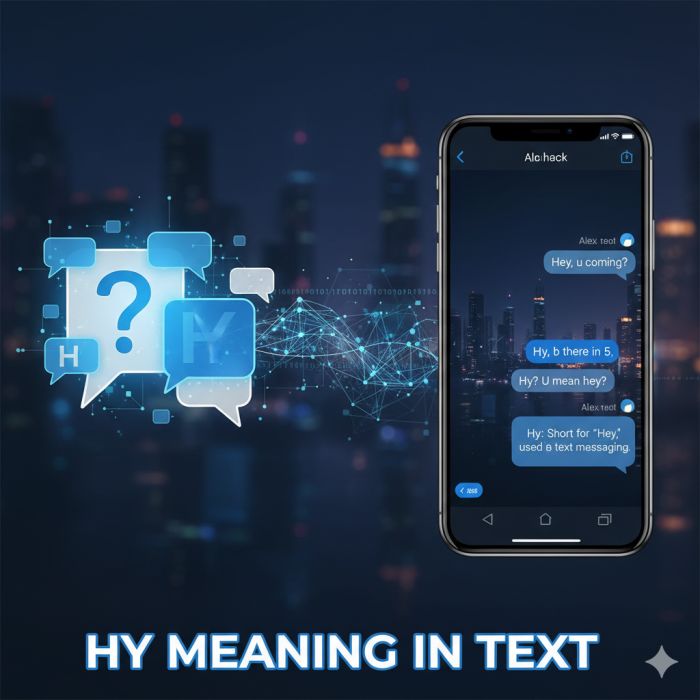“Hy Meaning in Text”

| Aspect | Details |
|---|---|
| Primary Keyword | hy meaning in text |
| Category | Digital communication, informal language, texting expressions |
| Core Interpretation | “Hy” is a shortened or informal variation of “Hi,” used as a casual greeting in digital messages |
| Common Usage Platforms | WhatsApp, Instagram, Snapchat, Facebook Messenger, TikTok comments, SMS |
| Tone Conveyed | Friendly, flirty, polite, soft, or sometimes sarcastic depending on context |
| Cultural Variations | Common in English-speaking and Asian texting cultures (especially Philippines, India, Pakistan, Malaysia) |
| Frequency of Usage | High among youth and informal chat settings |
| Grammatical Type | Interjection / Greeting Expression |
| Associated Expressions | hi, hey, heyy, hii, hello, yoo, wassup |
| Opposite Context | Ignoring messages, leaving on read, or responding with short replies |
| Emotional Spectrum | Friendly → Curious → Affectionate → Romantic → Bored |
| Text Tone Indicators | Use of emojis, repetition of letters, or capitalization patterns |
| Digital Communication Relevance | Indicates initiation of conversation or emotional tone softener |
Now Communication happens at lightning speed, abbreviations and short expressions dominate online interaction. One of the most common yet underestimated examples is the term “hy”, which appears frequently in chats, captions, and social media messages. Understanding the “hy meaning in text” is more than decoding a greeting; it reflects the psychology, tone, and context behind digital human connection. This article explores every dimension of this term its linguistic role, digital interpretation, emotional tone, variations, and how context alters meaning in communication.
What Does “Hy” Mean in Text?
“Hy” in text generally means “Hi”, an informal or stylized greeting used to start a conversation. It represents friendliness or the intent to connect. The spelling change from “Hi” to “Hy” often reflects personality, emotional tone, or a stylistic choice rather than a typographical error. People may use “Hy” to sound cute, gentle, or to stand out from regular messaging norms.
Etymology and Origin
The origin of “Hy” as a greeting traces back to early text messaging culture in the late 1990s when users shortened words to save space in SMS. Over time, this style evolved into a linguistic trend — where digital language favored uniqueness over correctness. Thus, “Hy” emerged as a creative variation of “Hi,” symbolizing personality and emotional nuance.
Usage Context in Messaging
In modern texting, “hy” is used across multiple emotional and situational contexts. It may signify friendliness, romantic interest, politeness, or curiosity. The meaning varies depending on punctuation, repetition, capitalization, and timing of the message. For instance, “Hy :)” can seem warm, while “Hy.” may sound distant.
Why Do People Use “Hy” Instead of “Hi”?
The use of “Hy” instead of “Hi” isn’t random — it reflects psychology, emotion, and personal tone. Several factors drive this linguistic choice.
1. Personalization in Communication
People use “Hy” to personalize a greeting. It’s a subtle way to show friendliness while being distinct. The alteration from “Hi” to “Hy” adds a personal mark that makes the message feel casual and non-generic.
2. Emotional Softening
“Hy” sounds visually softer than “Hi.” When people want to initiate a conversation without sounding too direct or assertive, they often prefer “Hy.” It’s an emotional softener that conveys warmth.
3. Digital Aesthetics
In modern texting culture, aesthetics matter. “Hy” fits into stylized texting alongside variations like “heyy,” “hii,” or “yo.” The look and rhythm of the word add visual appeal in informal settings.
4. Influence of Typing Patterns
Autocorrect, touch typing, and regional accents influence digital spelling. For some users, “Hy” might appear naturally due to phonetic comfort or accidental adaptation — later becoming habitual.
How Does Context Change the Meaning of “Hy”?
Context determines whether “hy” sounds polite, friendly, awkward, or flirtatious. Tone, timing, and message history all influence interpretation.
| Context | Example Usage | Interpretation |
|---|---|---|
| Friendly Greeting | “Hy! How are you?” | Warm and polite initiation |
| Romantic Approach | “Hy beautiful” | Flirty and affectionate tone |
| Apology Starter | “Hy, I’m sorry about yesterday” | Gentle re-entry after conflict |
| Formal Introduction | “Hy, I’m Alex from HR” | Professional politeness |
| Cold Message | “Hy.” | Emotionally distant or uninterested |
What Are the Emotional Interpretations of “Hy”?
Politeness and Friendliness
In general, “Hy” reflects a polite gesture to start a conversation or acknowledge someone. It helps establish comfort and break silence in chats.
Curiosity
When used at the beginning of random conversations — like “Hy?” — it shows curiosity or the intent to reconnect.
Flirtation
In romantic chats, “Hy” often carries flirtatious undertones. The simplicity of the word acts as an invitation for further dialogue.
Apology or Reconciliation
In emotional contexts, “Hy” acts as a soft reentry line — often used after arguments or periods of silence.
Casual Interest
Sometimes “Hy” is sent without deeper meaning, merely as a habitual greeting or casual message starter.
Is “Hy” Different from “Hey,” “Hi,” or “Hello”?
Yes, each of these greetings carries subtle emotional and contextual differences.
| Expression | Tone | Common Context | Emotional Effect |
|---|---|---|---|
| Hi | Neutral | General greetings | Balanced and standard |
| Hey | Friendly / informal | Friends or peers | Engaging and warm |
| Hy | Soft / stylized | Youth texting, flirty chats | Gentle and emotional |
| Hello | Formal | Professional or unknown contacts | Respectful and structured |
Variations and Related Forms of “Hy”
Hyy
Used playfully or flirtatiously, doubling the “y” extends friendliness or affection.
Hyyy
This extended version expresses excitement, happiness, or enthusiasm — often used in close friendships.
Hie
An uncommon but regional variation blending “Hi” with local pronunciation.
Hyyaa
Used to reflect cultural or humorous tone in Southeast Asian texting.
Hy 🙂
Combining “Hy” with an emoji amplifies warmth and friendliness.
How Does “Hy” Reflect Digital Psychology?
Digital communication psychology emphasizes tone projection through minimal text. “Hy” is a prime example of emotional compression — where a two-letter word conveys warmth, curiosity, or affection. The subconscious choice of “Hy” over “Hi” often mirrors the sender’s intent to appear non-threatening or emotionally gentle.
This behavior aligns with linguistic relativity in digital contexts — words change emotional weight depending on audience and platform.
Linguistic and Cultural Entities Related to “Hy”
| Entity | Sub-Entities | Description |
|---|---|---|
| Digital Language Evolution | Texting Slang, Emoji Culture, Phonetic Spelling, Internet Abbreviations | Represents transformation of language in online communication |
| Psycholinguistics of Greeting | Tone Perception, Word Softness, Conversational Entry, Emotional Comfort | Examines emotional triggers and reactions to greetings |
| Cross-Cultural Texting Norms | Asian Youth Language, Western Informality, Multilingual Adaptation, Regional Variants | Explains how “Hy” adapts across global cultures |
| Sociolinguistic Behavior | Gender-based Usage, Age Influence, Online vs Offline Speech, Emotional Intent | Analyzes social impact on digital greetings |
| Communication Dynamics | Message Timing, Response Length, Conversation Flow, Emotional Reciprocity | Highlights patterns created through “Hy” initiation |
How “Hy” Functions Across Cultures
Western Communication
In Western texting, “Hy” is rare but associated with cuteness or stylistic tone. Users prefer “Hey” or “Hi” for standard greetings.
Asian Youth Texting
In countries like India, Pakistan, Malaysia, and the Philippines, “Hy” is widely used as a modern shorthand for “Hi.” It signifies informality and friendliness.
European Digital Culture
Europeans prefer “Hey” or “Hello,” though “Hy” appears among younger generations influenced by global chat trends.
Middle Eastern Online Interaction
“Hy” is seen as approachable and polite, particularly among youth communicating in mixed English-Arabic slang.
Common Scenarios Where “Hy” Is Used
| Situation | Example Message | Implied Emotion |
|---|---|---|
| Starting a new conversation | “Hy, long time no see!” | Friendly interest |
| Responding late | “Hy, sorry for the delay.” | Apologetic |
| Reconnecting | “Hy again :)” | Nostalgic warmth |
| Romantic text | “Hy cutie” | Affectionate |
| Professional introduction | “Hy, I’m writing regarding the project.” | Courteous |
How to Respond When Someone Texts “Hy”
When someone sends “Hy,” the best response depends on your relationship and emotional context.
Friendly Response
“Hey! How have you been?” — keeps the conversation warm.
Romantic Response
“Aww, hy you ❤️” — shows affection and reciprocation.
Professional Response
“Hello! How can I help you?” — maintains decorum.
Neutral Response
“Hi” — polite but emotionally neutral.
Impact of “Hy” on Online Relationships
The first word in any conversation sets the tone. “Hy” often acts as a bridge between silence and dialogue. Its simplicity makes it a safe, universal opener. In friendships, it feels approachable; in romance, it feels soft; in professional messages, it can still pass as respectful when followed by context. The emotional elasticity of “Hy” makes it one of the most adaptable greetings in digital conversation.
Common Texting Acronyms and Slang Terms

| Acronym / Slang | Full Form / Meaning | Usage Example | Implied Tone / Context |
|---|---|---|---|
| LOL | Laugh Out Loud | “That meme was hilarious LOL” | Humor, amusement |
| BRB | Be Right Back | “Hold on, brb” | Temporary pause |
| TTYL | Talk To You Later | “Okay, ttyl!” | Ending a chat politely |
| OMG | Oh My God | “OMG, that’s amazing!” | Surprise or excitement |
| IDK | I Don’t Know | “IDK what to say” | Uncertainty |
| TBH | To Be Honest | “TBH, I liked your version better” | Sincerity or opinion |
| BTW | By The Way | “BTW, did you get my email?” | Adding extra information |
| IMO / IMHO | In My Opinion / In My Humble Opinion | “IMO, that movie was overrated” | Personal viewpoint |
| SMH | Shaking My Head | “SMH, people still believe that” | Disappointment or disbelief |
| ICYMI | In Case You Missed It | “ICYMI, the event got postponed” | Sharing updates |
| LMK | Let Me Know | “LMK when you’re free” | Request for information |
| FWIW | For What It’s Worth | “FWIW, you did great” | Offering gentle advice |
| RN | Right Now | “I’m busy rn” | Real-time update |
| IDC | I Don’t Care | “IDC anymore” | Disinterest |
| TMI | Too Much Information | “Okay, TMI dude!” | Oversharing reaction |
| LMAO | Laughing My Ass Off | “That video was insane LMAO” | Strong laughter |
| ROFL | Rolling On Floor Laughing | “ROFL that was epic!” | Extreme amusement |
| BFF | Best Friends Forever | “Love you, my BFF” | Friendship affection |
| FOMO | Fear Of Missing Out | “I got FOMO from that trip post” | Social anxiety or curiosity |
| YOLO | You Only Live Once | “Let’s go! YOLO!” | Boldness or spontaneity |
| DM | Direct Message | “Send me a DM” | Private communication |
| PM | Private Message | “I’ll PM you the details” | Confidential sharing |
| TTYS | Talk To You Soon | “Goodnight! TTYS” | Friendly farewell |
| GTG / G2G | Got To Go | “GTG, meeting’s starting” | Quick sign-off |
| ILY / ILU | I Love You | “ILY so much!” | Affection or love |
| NVM | Never Mind | “NVM, I figured it out” | Dismissal or correction |
| BTW | By The Way | “BTW, nice profile pic!” | Adding side info |
| AFK | Away From Keyboard | “AFK for a sec” | Temporary absence (gaming/chat) |
| TBT | Throwback Thursday | “#TBT to my 2015 vacation” | Nostalgia on social media |
| OOTD | Outfit Of The Day | “Posting my OOTD!” | Fashion-related post |
| HMU | Hit Me Up | “HMU when you’re online” | Invitation to connect |
| Bae | Before Anyone Else | “Going out with my bae” | Romantic partner |
| Thx / Tnx / Ty | Thanks | “Thx for helping!” | Gratitude |
| Pls / Plz | Please | “Plz send the file” | Request or politeness |
| Okie / K / KK | Okay | “Okie, will do!” | Agreement (tone depends on variant) |
| Sus | Suspicious | “That’s kinda sus…” | Doubt or skepticism |
| Bruh | Bro / Dude | “Bruh, seriously?” | Casual reaction |
| Cap / No Cap | Lie / No Lie | “That’s true, no cap” | Honesty indicator |
| GOAT | Greatest Of All Time | “Messi is the GOAT” | Praise or admiration |
| Salty | Bitter or Upset | “He’s still salty about it” | Annoyance |
| Ghosted | Ignored / Cut off contact | “She ghosted me after the date” | Relationship slang |
| Flex | Show off | “He loves to flex his car” | Pride or boasting |
| Lowkey / Highkey | Secretly / Obviously | “Lowkey I like it” / “Highkey that’s true” | Emotional emphasis |
| WYD | What You Doing | “Hey, wyd?” | Conversation starter |
| ICYDK | In Case You Didn’t Know | “ICYDK, we’re moving next week” | Informative tone |
| OMW | On My Way | “OMW now!” | Real-time update |
| GN / GM | Good Night / Good Morning | “GN, sleep tight!” | Casual greetings |
| Prolly | Probably | “Prolly gonna stay home” | Informal prediction |
| TBF | To Be Fair | “TBF, she had a point” | Balanced statement |
| SZN | Season | “It’s football szn!” | Cultural trend |
| Bet | Agreement / Challenge | “Bet! I’m in.” | Affirmation |
| W / L | Win / Loss | “That’s a W move” | Success or failure |
| IDGAF | I Don’t Give A **** | “IDGAF about that drama” | Indifference |
Linguistic and Social Importance of Texting Acronyms
Acronyms and slang terms are not merely shortcuts; they serve as social markers that reveal personality, belonging, and digital fluency. Younger users tend to adopt and adapt these expressions faster, creating microcultures within digital platforms. Their brevity enables high-speed emotional communication, allowing users to express humor, frustration, or excitement in minimal words.
Cultural Dynamics Behind Texting Slang
Youth Influence
Teenagers and young adults drive the evolution of slang through platforms like TikTok, Instagram, and X (formerly Twitter). They continuously innovate abbreviations to maintain exclusivity and novelty.
Regional Adaptation
Certain acronyms acquire regional meanings. For example, “bruh” or “fam” has deep roots in African-American Vernacular English but has since become mainstream globally.
Technological Impact
Auto-correct and predictive text shape spelling variations like “plz” for “please” or “thx” for “thanks,” reflecting device-influenced evolution.
Emotional Expressiveness
Texting slang compensates for the absence of facial cues in online communication, using abbreviations and capitalization to convey tone.
Common Emotional Categories in Texting Slang
| Emotional Category | Representative Acronyms / Slang | Usage Context |
|---|---|---|
| Humor & Laughter | LOL, LMAO, ROFL | Expressing amusement |
| Affection & Friendship | BFF, ILY, Bae | Showing love or connection |
| Agreement & Enthusiasm | Bet, W, GOAT | Positive engagement |
| Disappointment & Frustration | SMH, IDC, IDGAF | Negative or indifferent tone |
| Information & Updates | BTW, ICYMI, OMW | Practical communication |
| Casual Politeness | Ty, Plz, Okie | Soft politeness in texting |
Why Learning Texting Slang Matters
- Improves Online Communication: Knowing slang helps users interpret tone accurately, reducing misunderstandings.
- Enhances Social Adaptation: Understanding modern digital lingo fosters inclusivity in online communities.
- Reflects Cultural Awareness: Language adapts with technology, and slang terms mirror social evolution.
- Builds Relatable Connections: Using common slang appropriately strengthens rapport in messaging.
Integration of “Hy” Within Modern Slang
Interestingly, “Hy” itself functions as a minimalistic slang greeting within this ecosystem. Like “WYD” or “GM,” it compresses intent into two letters — combining brevity with emotional expression. Its popularity among youth aligns it with other friendly openers such as “hey,” “yo,” and “sup.”
Conclusion on Texting Acronyms and Slang
Texting acronyms and slang have transformed digital communication into a rapid, expressive form of social interaction. They act as linguistic fingerprints of the digital generation, constantly evolving with trends, memes, and cultural shifts. Recognizing expressions like LOL, BRB, or even “Hy” ensures not only understanding but also belonging in the digital social sphere.
Conclusion
Understanding the “hy meaning in text” reveals that it’s not merely a misspelling but a social signal shaped by personality, culture, and emotion. It carries warmth, curiosity, and connection — compacted into two simple letters. From casual chats to emotional apologies, “Hy” plays a pivotal role in how people initiate and sustain conversations in the digital era. Its adaptability across cultures and platforms highlights the evolving beauty of modern communication — where even the shortest words can express the deepest emotions.
FAQs
1. What does “hy meaning in text” actually represent?
It represents an informal way of saying “Hi,” used commonly in chats, social media, and messaging apps to start conversations.
2. Is “Hy” grammatically correct?
Not in traditional grammar, but it’s accepted in digital communication as a stylistic greeting.
3. Is there a difference between “Hi” and “Hy”?
Yes, “Hi” is standard, while “Hy” is more casual, emotional, and often used by younger generations.
4. Does “Hy” mean someone likes you?
Sometimes yes — in flirty or affectionate contexts, “Hy” can indicate interest or emotional closeness.
5. Can “Hy” be used in professional communication?
It can be used politely but sparingly; “Hello” or “Hi” is preferred in formal messages.
6. What does it mean if someone sends “Hy” with a smile emoji?
It often conveys friendliness, warmth, or an attempt to reconnect positively.
7. Why is “Hy” popular in Asian texting culture?
Because it’s short, visually soft, and matches phonetic pronunciation habits of English learners in the region.






